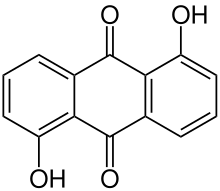 | |
| Names | |
|---|---|
| Other names 1,5-dihydroxy-9,10-anthracenedione, 1,5-dihydroxyanthraquinone, Anthrarufin | |
| Identifiers | |
| CAS Number | |
| 3D model (JSmol) | |
| Beilstein Reference | 1881718 |
| ChEBI | |
| ChEMBL | |
| ChemSpider | |
| ECHA InfoCard | 100.003.796 |
| EC Number |
|
| Gmelin Reference | 144152 |
| PubChem CID | |
| UNII | |
| CompTox Dashboard (EPA) | |
InChI
| |
SMILES
| |
| Properties | |
| Chemical formula | C14H8O4 |
| Molar mass | 240.214 g·mol |
| Appearance | orange solid |
| Density | 1.56 g/cm |
| Melting point | 280 °C (536 °F; 553 K) |
| Hazards | |
| GHS labelling: | |
| Pictograms | 
|
| Signal word | Warning |
| Hazard statements | H315, H319, H335 |
| Precautionary statements | P261, P264, P264+P265, P271, P280, P302+P352, P304+P340, P305+P351+P338, P319, P321, P332+P317, P337+P317, P362+P364, P403+P233, P405, P501 |
| Except where otherwise noted, data are given for materials in their standard state (at 25 °C , 100 kPa). Infobox references | |
1,5-Dihydroxyanthraquinone is an organic compound with the formula (C6H3OH)2(CO)2. It is one of several isomers of dihydroxyanthraquinone. An orange solid, it is a component of traditional Chinese medications. It serves as a chelating ligand for transition metals.
References
- Marasinghe, P. A. B.; Gillispie, G. D. (1993). "Structure of 1,5-dihydroxyanthraquinone: A redetermination". Acta Crystallographica Section C Crystal Structure Communications. 49 (1): 113–114. Bibcode:1993AcCrC..49..113M. doi:10.1107/s0108270192004542.
- "1,5-Dihydroxyanthraquinone". pubchem.ncbi.nlm.nih.gov.
- Cai, Yi-Zhong; Mei Sun; Jie Xing; Luo, Qiong; Corke, Harold (2006). "Structure–radical scavenging activity relationships of phenolic compounds from traditional Chinese medicinal plants". Life Sciences. 78 (25): 2872–2888. doi:10.1016/j.lfs.2005.11.004. PMID 16325868.
- Lin, Yue-Jian; Han, Ying-Feng; Jin, Guo-Xin (2012). "Synthesis and Structural characterization of half-sandwich iridium macro-metallacycles containing 1,5-dihydroxy-9,10- anthraquinone ligand". Journal of Organometallic Chemistry. 708–709: 31–36. doi:10.1016/j.jorganchem.2012.02.014.
| Types of natural anthraquinones | |
|---|---|
| Dihydroxyanthraquinones | |
| Trihydroxyanthraquinones | |
| Tetrahydroxyanthraquinones | |
| Misc: | |